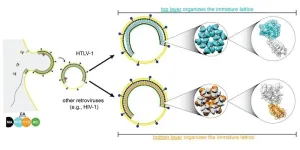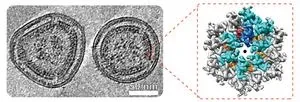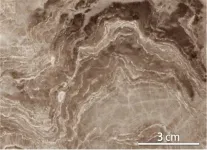(Press-News.org) Martin Obr is on edge, anxiously waiting for his train to the airport. A storm called “Sabine” is brewing, shutting down all public transport. He catches his flight from Frankfurt to Vienna just in time.
Obr spent the last days in Germany meticulously analyzing what he calls the “perfect sample”. This sample helped him and Florian Schur from the Institute of Science and Technology Austria (ISTA) decode the structure of a virus called HTLV-1 (Human T-cell Leukemia Virus Type 1).
In collaboration with the University of Minnesota and Cornell University, the scientists provide new details into the virus’ architecture using Cryo-Electron Tomography (Cryo-ET)—a method to analyze the structures of biomolecules in high resolution. Their results were published in Nature Structural & Molecular Biology.
The cousin of HIV
Obr and Schur first crossed paths while working on HIV-1 (Human Immunodeficiency Virus Type 1), aiming to better understand its structure. Obr then joined Schur’s research group at ISTA as a postdoc. They shifted their focus to HTLV-1—a lesser-known virus from the same retrovirus family as HIV-1—due to a limited understanding of its architecture. “HTLV-1 is somewhat the overlooked cousin of HIV,” says Schur. “It has a lower prevalence than HIV-1, yet there are many cases around the world.”
According to the World Health Organization, between 5 and 10 million people are currently living with HTLV-1. While most of the infections remain asymptomatic, roughly 5% lead to aggressive diseases like adult T-cell leukemia/lymphoma—a form of cancer with a prognosis of less than a year.
“As a human pathogen causing severe diseases, HTLV-1 should be at the forefront of our research to address the questions about its functions and structure,” adds Obr.
The viral lattice
The scientists were particularly interested in the virus particle’s structure—information that remained elusive until now. “When a virus gets produced, it generates a particle. This particle, however, is not yet infectious. The immature virus particle must undergo a maturation process to become infectious,” explains Schur.
The HTLV-1 particle is shaped by a lattice of proteins (building blocks) arranged into a spherical shell. This shell serves a critical function: it protects the viral genetic material until the host cell is infected. But what does this lattice look like in detail, what are its key components, and does it vary from other viruses?
“We were expecting a difference from other viruses, but the extent of it completely blew us away,” says Obr.
A unique virus
The scientists’ analysis revealed that the lattice of immature HTLV-1 is remarkably distinct from other retroviruses. Its building blocks are put together in a unique fashion, and as a result, its overall architecture looks different. Additionally, the ‘glue’ that holds the construct together also differs. In most retroviruses, the lattice consists of a top and a bottom layer; typically, the bottom layer acts as the glue, maintaining structural integrity, while the top layer defines the shape. “In HTLV, it’s the other way around. The bottom layer is basically just hanging by a thread,” says Schur.
Naturally, the question of why HTLV-1 has such a different lattice architecture arises. A possible explanation might be that HTLV-1 has a unique way of transmission. HTLV-1 prefers to have one infected cell next to an uninfected one to spread with direct contact. HIV-1, on the other hand, uses cell-free transmission. It produces particles that can travel anywhere in the bloodstream.
“From an evolutionary standpoint, it was probably advantageous for HTLV-1 to change its lattice structure for this kind of transmission. Nevertheless, at this point, it is only speculation. It needs to be experimentally verified,” Obr continues.
New treatment strategies?
Understanding these structural details is a crucial step forward, as the paper could pave the way for novel treatment approaches to combat HTLV-1 infections.
There are different ways to interfere with retrovirus infectivity. For example, one could block the mature virus at the stage of infection. Alternatively, one could target the immature virus and prevent it from maturing and becoming infectious. Since the scientists’ study details the architecture of the immature virus, one can now think of strategies for tackling the virus during this stage of its maturation.
“There are types of viral inhibitors that disrupt the assemblies by targeting the building blocks to prevent them from coming together. Others work by destabilizing the lattice,” says Schur. “There are many possibilities.”
The perfect ‘ice cold’ sample
Despite their experience analyzing viruses of the same family, such as HIV-1, the team’s current research project on HTLV-1 brought its unique challenges. Obr’s “perfect sample” was the turning point.
Due to safety reasons, the sample does not contain the actual virus. Instead, the scientists produced viral-like particles in mammalian cell cultures or generated the viral building blocks in bacterial cultures. “When these building blocks are placed in the correct conditions, they self-assemble into structures that resemble the actual immature virus,” explains Schur. These non-infectious particles are then rapidly frozen, stored at -196 °C in liquid nitrogen, and eventually imaged using a Cryo-Electron Microscope (Cryo-EM)—a type of microscope that captures high-resolution images down to a nanometer.
But can we be sure the scientists are looking at the real thing?
A valid concern, as Obr notes, “Our virus-like particles only lack a few enzymes that would help them to mature. There is no reason to think the real immature particle does look different.” This careful approach, however, ensures that researchers can study viruses safely while still gaining invaluable insights.
END
A viral close-up of HTLV-1
New insights about the structure of a remarkably distinct virus related to HIV
2024-09-25
ELSE PRESS RELEASES FROM THIS DATE:
Virtual reality can help pedestrians and cyclists swerve harmful pollutants – study
2024-09-25
Physics-informed virtual reality could be key to reducing the exposure of pedestrians and cyclists to harmful, non-exhaust vehicle emissions, according to a study published today (25 Sep) in the Royal Society Open Science journal.
The research lead by the University of Birmingham (supported by Rosetrees Trust and Research England QR Funding), targets the issue of major health risks and chronic diseases caused by exposure to unregulated particle pollutants from road, tyre and brake sources by providing easy, accessible guidance to the public, policy makers, and city planners, through immersive VR experiences.
Detailed ...
Neuroscience luminary Hermona Soreq sheds light on the roles of RNA regulators in neurodegenerative diseases
2024-09-25
In a compelling Genomic Press Interview published in Brain Medicine on September 25, 2024, Professor Hermona Soreq of the Hebrew University of Jerusalem in Israel unveils the profound implications of her groundbreaking research on the cholinergic system and small RNA regulators in brain-body communication.
Prof. Soreq, holder of the Endowed Slesinger Professorship of Molecular Neuroscience, has dedicated her career to unraveling the complexities of the parasympathetic nervous system, with a particular focus on acetylcholine's role in stress responses and neurodegenerative diseases. Her work has revolutionized our understanding of how the brain ...
Ancient reef-builders dodged extinction — at least temporarily
2024-09-25
Will modern coral reefs go extinct? The answer is uncertain, but some of their ancient counterparts managed to dodge a bullet — for a while, at least.
Scientists from Osaka Metropolitan University have discovered that ancient reef-building organisms called stromatoporoids survived the Late Devonian mass extinction event and continued to thrive as major reef-builders long after their presumed extinction. These findings shed light on how life on Earth has responded to past environmental changes, offering ...
Citizen scientists help discover microplastics along the entire German coastline
2024-09-25
The global production of plastics and the resulting plastic waste has increased to such an extent that plastics have become ubiquitous in our environment. Plastics of various sizes are also found along the German North Sea and Baltic coasts. Previous studies of microplastic pollution on German beaches have often been limited to a few locations. In the citizen science project “Microplastic Detectives”, researchers from the Alfred Wegener Institute, together with citizens, have now collected samples from beaches along the entire German coast to be analyzed for microplastics. The resulting dataset is the first to be large enough to ...
Rising waters, waning forests: How scientists are using tree rings to study how rising sea levels affect coastal forests
2024-09-25
Sunlight filters through the canopy of pines, holly, sweet gum, and red maple while bird calls echo in the distance. These coastal forests may seem like others in the Mid-Atlantic, but a hidden challenge looms. Standing tall next to their salt marsh neighbors, where the wind carries the sharp scent of sulfidic seawater, these trees are more than just part of the landscape—they are living monuments to a rapidly changing environment. As sea levels rise, the future of these forests is uncertain. While the adjacent salt marshes can adapt to encroaching waters, the trees, vulnerable to the increasing frequency ...
Night-time noise linked to restless nights for airport neighbours
2024-09-25
Noise from aircraft at night is linked with disturbed sleep quality and sleep-wake cycle, a new study using movement trackers has shown.
Environmental health experts at the University of Leicester combined measurements from activity monitors and self-reported sleep information for the first time to put together a more detailed picture of how aircraft noise impacts sleep, in the largest such study to date.
The results, published in Environmental Health Perspectives, show that people exposed to higher levels of night-time aircraft noise experienced more restlessness during sleep and disruption in daily sleep rhythm, even if they had a full night’s sleep.
The team was led from the ...
Fossils from the Adriatic Sea show a recent and worrying reversal of fortunes
2024-09-25
If you’d stopped monitoring the Adriatic Sea’s marine life in the mid-20th century, the outlook would have been promising. Snails and the clams they hunt for food increased in abundance for several decades during the late 1800s and early 1900s, evidence of a vibrant and healthy ecosystem.
Then, a threshold was crossed. Populations of both predator and prey abruptly plummeted and in some cases disappeared entirely. They were replaced by the common corbulid clam (Varicorbula gibba), which has the ability to slow down its metabolism in unfavorable conditions. Whenever paleontologists find an abundance of this species in the marine fossil record, it often means ...
With curtailed carbon emissions, corals can survive climate change
2024-09-25
KANEOHE, HI (Sept 24, 2024 1:05 p.m. HST)- In a study published today in Proceedings of the Royal Society B, researchers at the UH Hawaiʻi Institute of Marine Biology (HIMB) Toonen- Bowen “ToBo” Lab have identified scenarios under which eight of the most common species of coral found in Hawaiʻi can adapt to and survive ocean warming and acidification. The corals in the study are prevalent throughout the Indo-Pacific, a region that comprises more than two-thirds of the coral reefs on planet Earth, and were found to be capable of surviving a “low ...
Global prevalence of short-sightedness in children and teens set to top 740 million cases by 2050
2024-09-24
Around 1 in 3 children and teens around the world is short (near)-sighted, with the global prevalence of myopia set to top 740 million cases by 2050 in this age group, finds a pooled data analysis of the available evidence, published online in the British Journal of Ophthalmology.
Female sex, East Asian or urban area residence, and educational level all seem to be key factors influencing prevalence, the findings indicate.
Short (near)-sightedness (myopia), which describes difficulty seeing objects at a distance, typically starts in early childhood and tends to worsen with age, explain the researchers. It has emerged ...
Urgent rethink of bottled water’s huge and growing toll on human and planetary health
2024-09-24
The huge and growing toll bottled water is taking on human and planetary health warrants an urgent rethink of its use as 1 million bottles are bought every minute around the globe, with that figure set to rise further still amid escalating demand, warn population health experts in a commentary published in the open access journal BMJ Global Health.
Some 2 billion people around the world with limited or no access to safe drinking water rely on bottled water. But for the rest of us, it’s largely a matter of convenience and the unshaken belief—aided and abetted by industry marketing—that bottled water is safer and often healthier than tap ...
LAST 30 PRESS RELEASES:
Injectable breast ‘implant’ offers alternative to traditional surgeries
Neuroscientists devise formulas to measure multilingualism
New prostate cancer trial seeks to reduce toxicity without sacrificing efficacy
Geometry shapes life
A CRISPR screen reveals many previously unrecognized genes required for brain development and a new neurodevelopmental disorder
Hot flush treatment has anti-breast cancer activity, study finds
Securing AI systems against growing cybersecurity threats
Longest observation of an active solar region
Why nail-biting, procrastination and other self-sabotaging behaviors are rooted in survival instincts
Regional variations in mechanical properties of porcine leptomeninges
Artificial empathy in therapy and healthcare: advancements in interpersonal interaction technologies
Why some brains switch gears more efficiently than others
UVA’s Jundong Li wins ICDM’S 2025 Tao Li Award for data mining, machine learning
UVA’s low-power, high-performance computer power player Mircea Stan earns National Academy of Inventors fellowship
Not playing by the rules: USU researcher explores filamentous algae dynamics in rivers
Do our body clocks influence our risk of dementia?
Anthropologists offer new evidence of bipedalism in long-debated fossil discovery
Safer receipt paper from wood
Dosage-sensitive genes suggest no whole-genome duplications in ancestral angiosperm
First ancient human herpesvirus genomes document their deep history with humans
Why Some Bacteria Survive Antibiotics and How to Stop Them - New study reveals that bacteria can survive antibiotic treatment through two fundamentally different “shutdown modes”
UCLA study links scar healing to dangerous placenta condition
CHANGE-seq-BE finds off-target changes in the genome from base editors
The Journal of Nuclear Medicine Ahead-of-Print Tip Sheet: January 2, 2026
Delayed or absent first dose of measles, mumps, and rubella vaccination
Trends in US preterm birth rates by household income and race and ethnicity
Study identifies potential biomarker linked to progression and brain inflammation in multiple sclerosis
Many mothers in Norway do not show up for postnatal check-ups
Researchers want to find out why quick clay is so unstable
Superradiant spins show teamwork at the quantum scale
[Press-News.org] A viral close-up of HTLV-1New insights about the structure of a remarkably distinct virus related to HIV









